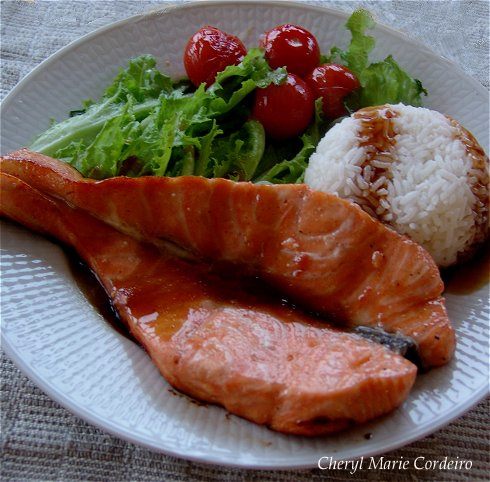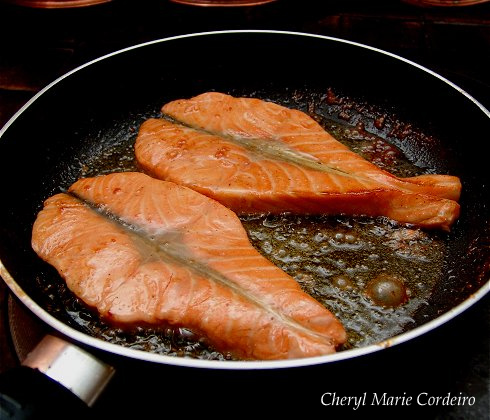
Salmon served with teriyaki sauce. On the side are rice, lettuce and tomatoes.
Photo for CMC © Jan-Erik Nilsson, 2009.
This is not much of a recipe, it’s more like a reminder that there are such simple and easily cooked dishes that combine luxury with a superb health aspect, such as this salmon plate that basically dribbles with heart friendly Omega 3 fat.
A butterfly fillet is a straight cut from a salmon fillet. You either buy them ready or cut the un-skinned thick fillet crosswise in about 3-4 cm (1-1.5 inch) wide slices. Then take each of these slices and make a cut down to (but not through) the skin. Fold out and you’re done.
Regarding how to fillet and tidy up a salmon, there are tons of short films available on Youtube. Since I have grown up in an Asian tradition where you take care of and use almost everything of your raw ingredients, I found myself noting how much of the salmon gets thrown away during the filleting process. Few videos for example, recommend keeping the salmon head and cooking with it.
While traditional Indian Fish Head Curry doesn’t use salmon head, my recent dining at an Indian restaurant in Gothenburg, where they served salmon curry indicated that perhaps salmon head could be used in that dish. Salmon skin is also often stripped and thrown away. In Japanese cooking, salmon skin is fried to a crisp and eaten in sushi rolls. The taste is fantastic! I would personally hate to think that one starts out with a healthy 40 lbs (20 kg) salmon and end up with maybe less than 5 kg worth of salmon fillet left to eat.
Of course there are different schools of thought in cooking, one of which is where you tidy up everything before you cook, and the other philosophy is that you cook as much as possible and tidy things up when or immediately before you eat. If you’re looking at a hypothetical dichotomy in schools of thought, then the results of the first method would produce close to industrially processed foods which could end up quite sterile and tasteless once you’ve de-boned, de-fatted and de-skinned everything, and the second would produce more home style home cooking that uses bones and skin etc. to produce thick broth bases that could be further used in the cooking process. And as one could expect, the latter school of thought produces food that are infinitely much more flavourful.
When it comes to cooking a salmon butterfly fillet, this idea means that you of course leave the skin and the fat linings on the fish in the first place and cook as is. This way you will gain the benefits of the healthy Omega 3 fat from the salmon and if you like you can add some extra butter to capture the mild flavour of the fish.

Salmon fillets frying in butter.
In our household, we add as little spice as possible so as not to kill the natural flavour of one of the best fishes there is to be had. Salt is usually enough to bring out the savoury taste of this fish, but we like to add some freshly grounded black pepper too.
Since salmon can be eaten raw, there’s no real worry about undercooking it. Use slow heat until the skin is crisp and the fish can be parted with a fork.
Serve if you like with fresh lemon, sprinkle with some extra salt, some like mayonnaise or a dash of Japanese teriyaki sauce. A mixture of sweet mustard and a dollop of crème fraîche or sour cream, might turn out a success.